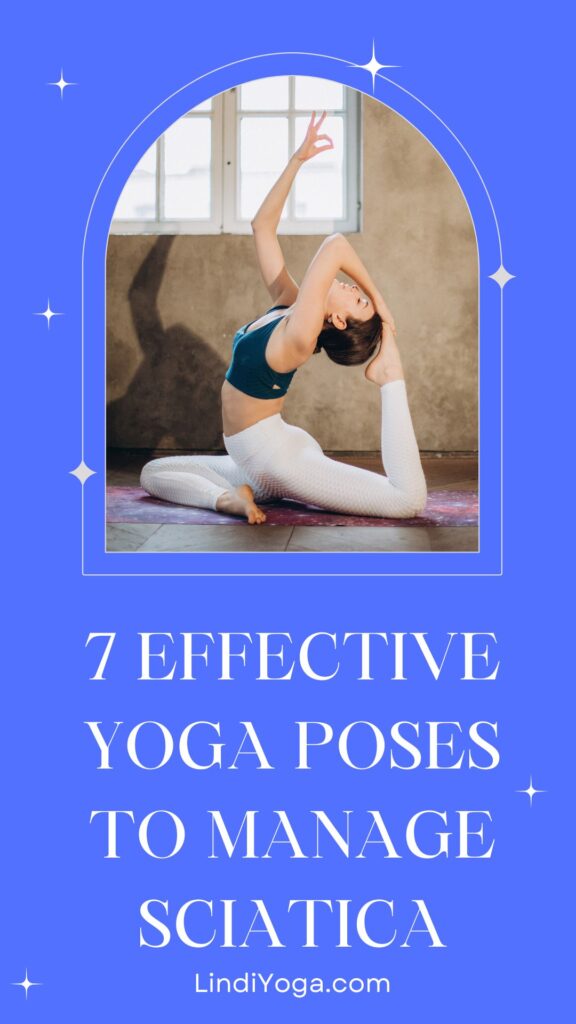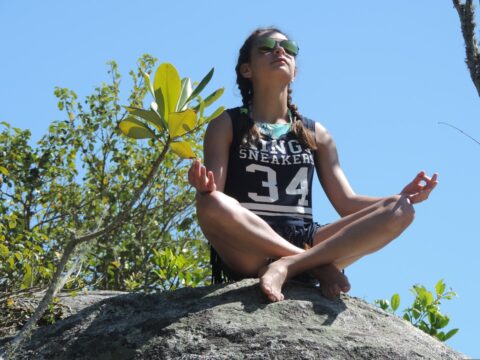Yoga for sciatica? Practising yoga poses for sciatica is a good way to relieve the pain and improve your posture. Make sure you only do gentle yoga poses if you suffer from sciatica.
Always remember to take the time to try different poses and see which one feels best for you. You will be amazed at how much it changes your body. If you do these poses correctly, you will feel better and more confident than ever.
And very importantly, talk to your doctor and an experienced yoga teacher before you start.
Some of the best yoga poses for sciatica are those that stretch the chest, shoulders and abdomen. You can start by lying on your stomach, bending your knees and resting your arms at your sides.
Podcast
A beneficial yoga pose for sciatica pain is the bridge pose. This pose allows you to strengthen your gluteus maximus, which is responsible for supporting your spine. In addition, it is a great way to stretch your lower back.
Downward facing dog is another yoga pose that offers many benefits, including pain relief and alignment. It also stretches the entire back and strengthens the hip area. It is a great pose for sciatica and can be done on either side. If you have upper back pain, you can also try the child’s pose.
The half lord pose helps stretch your back muscles and lengthen your spine. It also helps relieve stiffness in your hips and knees. Repeat this twist on both sides for maximum benefit. You can also try the bridge pose to strengthen your core and gluteal muscles.
As with any exercise, some poses can cause or aggravate sciatica symptoms. You should listen to your body when doing yoga and stop if you feel pain or discomfort. Also, consult a doctor and yoga instructor who is certified in the treatment of sciatica. This way he can guide you properly and offer modifications if needed.
What is sciatic nerve pain?
Sciatic nerve pain is a common complaint and can range from a dull ache to a sharp pain. It usually occurs on one side of the leg and can make it difficult to walk or stand.
The pain is usually sharp and can also be felt along the sole of the foot. Severe cases of sciatica can also lead to weakness in the affected limb. Various options are available to treat the pain, including yoga exercises, meditation, medication and surgery.
Depending on where the sciatic nerve is located, it can be difficult to determine if you have sciatica. Symptoms vary depending on the location of the disc and your particular condition. In most cases, sciatic pain only occurs when you bend forward.
Injections can be used to relieve the pain. Other treatments include medications that reduce inflammation. However, nerve pain is notoriously difficult to treat and should always be examined by a doctor.
Surgery is an option for treating severe sciatica, but should only be considered as a last resort. Often sciatica gets better on its own, but sometimes it comes back.
Common symptoms of sciatica
While sciatica symptoms can often go away on their own, some people need treatment. These treatments can consist of physiotherapy, yoga, medication and injections to reduce swelling.
In more severe cases, surgery may be needed to decompress the spine. However, non-surgical treatments should be tried first to relieve the pain and discomfort.
Common symptoms of sciatica are numbness, tingling or pain in the affected leg. These symptoms usually worsen with activities such as prolonged sitting, coughing or sneezing. People with severe cases may also have difficulty controlling their bowel movements or bladder. Some people also have problems with their balance.
Sometimes surgery is needed for sciatica. There are two types of sciatica surgery: microdiscectomy and discectomy. Both procedures involve removing part of the disc that is pressing on the sciatic nerve. The surgical procedures are performed through a small incision and under the supervision of a surgeon. Patients usually have to lie on their side with a pillow under their head.
Sciatica is often caused by a herniated disc in the lower back. However, it can also be caused by other conditions such as bone spurs on the vertebrae of the lower back.
Regardless of the cause, sciatica can be a very frustrating condition. Even more frustrating is the fact that it can limit mobility. Most mild cases go away on their own over time, but if your sciatica symptoms are severe, you should see a doctor to get an accurate diagnosis.
You should also see a doctor if your symptoms last longer than three weeks. You should also see a doctor if you develop other symptoms such as fever, nausea or difficulty controlling your bowel movements.
Common causes of sciatic pain
Sciatic pain is the result of a pinched nerve in the lower lumbar region. This can occur as a result of various injuries. One of the most common causes is a herniated or prolapsed disc.
These discs are cushions between the vertebrae of the spine. When they weaken, they can put pressure on the nerve root, which can lead to pain.
Other common causes are trauma to the lumbar region, e.g. from accidents or strenuous exercise. Another cause of sciatic pain is tumours in the spine that can press on the sciatic nerve.
These tumours are usually benign, but sometimes they can be malignant. A misaligned spine can also cause sciatic pain.
Different lifestyle habits can also contribute to the development of sciatica. For example, people with diabetes have an increased risk of developing the condition.
People who lead a sedentary lifestyle are also more prone to sciatica. Smoking can weaken the bones and increase wear and tear on the discs.
If you suffer from sciatica pain, a physiotherapist can help you determine the cause of the pain and the best course of action.
Non-surgical treatments include applying heat or cold packs to the affected area to reduce swelling. In most cases, non-surgical treatments for sciatica pain can relieve the pain and restore normal movement.
Supportive yoga poses for sciatica
Reclining Hand to Big Toe Pose ( Supta Padangusthasana )
The lying hand to big toe pose is beneficial for a number of health problems, including lower back pain. It also stretches the hips, hamstrings and calves.
In addition, it strengthens the muscles around the knees and improves digestion. Beginners can benefit from this pose. It is also a safe way to stretch the hamstrings as it does not strain the spine.
The first step in lying hand to big toe is to raise the left leg. To do this, you need to bend the knee of the resting leg. In this way you ensure that the leg is extended and your knee is not overloaded.
The next step is to lower the leg towards the floor. Once it is closer to the floor, bend the knee slightly and try to feel a sensation in the back of the thigh and the belly of the muscle. You should also open your hips slightly to ease the pain in your leg.
Triangle Pose ( Utthita Trikonasana )
Triangle Pose is a yoga pose that helps strengthen and stretch the spine. It is also an effective remedy for lower back pain and sciatica. The exercise can be done against a wall or with a block for balance. The body should be in a balanced position.
This yoga pose helps to restore a healthy curve to the lumbar spine, reducing pressure on the discs and relieving sciatica symptoms.
Sciatica is caused by a misalignment of the lumbar spine, which can put pressure on the sciatic nerve. This is usually the result of poor posture and muscular imbalance between the lower back and the abdominal muscles.
Half forward bend standing ( Ardha Uttanasana )
If you suffer from sciatica, you should do the half forward bend very carefully and only under the supervision of a yoga teacher. It puts strain on the lower back.
You can practise a half forward bend while standing by sitting on a stability ball. First place your hands on the ball and then bend your knees towards your chest.
Hold the stretch for two to three seconds and then return to your starting position. If you are looking for a greater challenge, you can also try the pose on the other side.
If you do not feel any pain when performing the pose, try stretching your lower back with your hands. The stretch should be gentle. Hold it for two to three seconds and then return to the starting position. This stretch can also help relieve discomfort caused by sciatica.
Extended Side Angle Pose ( Utthita Parsvakonasana )
When practising the Extended Side Angle Posture for sciatica, be sure to maintain proper alignment of the hips. It is common for beginners to shift their knees forward and take their weight off their hips during this pose.
To avoid this problem, it is best to keep the back straight and the hips square to the long edge of the mat between the feet. It is also important to keep the shoulders over the hips and the spine straight.
To perform the Extended Side Angle pose, first lie on your right thigh. Place your fingertips on the floor outside your right foot.
Hold the stretch for thirty seconds to one minute and exhale as you release. Repeat as often as possible to improve your flexibility and strength in the hips.
Bharadvajas Twist ( Bharadvajasana I )
The Bharadvajas twist is an asana or twist that helps to relieve tension in the spine and improve circulation to the abdominal organs.
The twist, which was already used in ancient Vedic times, is a simple but effective asana. It is named after Bharadvaja, an ancient Vedic sage and father of Drona, the military master from the Mahabharata epic.
To perform the Bharadvaja’s Twist, you need to bend your knees. You should also have a good lower back and a relaxed stomach. Also, place your left hand under your right knee, next to your right buttock. You can also squeeze your shoulder blades together while turning your upper body to the right.
Yoga Bridge Pose ( Sethubandha Asana )
This gentle backbend is a great way to strengthen your gluteal muscles and stretch your lower back. First lie on your back and stretch your hip flexors.
Then bring your feet together so that you form a straight line from your knees to your shoulders. Hold the position for 5 seconds and then lower your hips.
Next try a supported bridge pose, placing a block under your sacrum. This will provide additional support to the weak areas of your back and reduce the risk of re-injury.
However, be sure to place the block so that it rests evenly on your back. Remember that your sacrum should always be the first target and you should not place the block too far back or on your tailbone.
It is important to perform the exercise correctly to avoid injury. The seated version of the pose is a good way to stretch your piriformis. Make sure you hold it without straining and you will be well on your way to pain-free sciatica!
Yoga Cobra Pose ( Bhujangasana )
This yoga pose trains the middle of the body and the lower back. To perform the pose correctly, it is important to keep the neck neutral and tense the lower abdominal area. In this pose it is also important to breathe deeply. This pose also increases the flexibility of the spine and stretches the lower back.
This yoga pose can be very helpful for sciatica patients as it can strengthen the back. You should perform this pose slowly.
Sciatica is often the result of a misalignment of the lumbar spine, which puts pressure on the sciatic nerve. The cause of this misalignment is usually bad posture habits.
People who have poor posture have tight hamstrings, gluteal muscles and hip flexors, which puts pressure on the spine.
In addition, tight muscles can cause imbalances in the lower back and abdominal muscles. If you correct these imbalances, you can reduce the pressure on the discs.
If you are not sure whether yoga poses are suitable for you, you should first consult a doctor.




